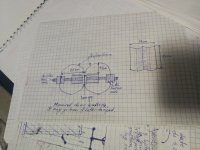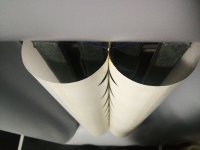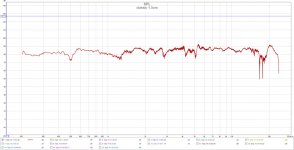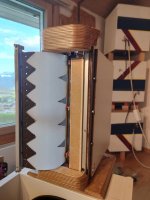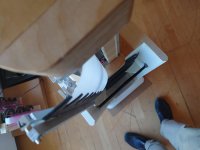Hello
Are you really serious? Such simulations need very precise data. A little more laquer and the whole thing already sounds different. Is that possible with my added suspension? And then there is the damping material, the properties of which are not known. The strength of the paper is also not known.
There shouldn't be standing waves, shouldn't there?
Well, maybe sergiu can provide the data
regards
Are you really serious? Such simulations need very precise data. A little more laquer and the whole thing already sounds different. Is that possible with my added suspension? And then there is the damping material, the properties of which are not known. The strength of the paper is also not known.
There shouldn't be standing waves, shouldn't there?
Well, maybe sergiu can provide the data
regards
Thanks Sparrowlegs,
There is no secret, it never was. I posted everything here so that everyone could do it. Again, if someone finds out more please post. I'm looking forward for futher upgrades. Here are my actual dimensions, measured now. Pics bellow.
The cils shape is a bit of a butterfly shape, not perfectly round (abit oval to the center and round to the exterior verical Al clamping rod edges) .. It measured better and had better performance soundwise, as you have seen from my previous measurements. The verical Al rods for clamping are damped with foam at the contact with the membranes. I took a pic because i dont think i could drow so explicitly.
Looking forward for the sims.
Cheers
There is no secret, it never was. I posted everything here so that everyone could do it. Again, if someone finds out more please post. I'm looking forward for futher upgrades. Here are my actual dimensions, measured now. Pics bellow.
The cils shape is a bit of a butterfly shape, not perfectly round (abit oval to the center and round to the exterior verical Al clamping rod edges) .. It measured better and had better performance soundwise, as you have seen from my previous measurements. The verical Al rods for clamping are damped with foam at the contact with the membranes. I took a pic because i dont think i could drow so explicitly.
Looking forward for the sims.
Cheers
Attachments
Hello
Are you really serious? Such simulations need very precise data. A little more laquer and the whole thing already sounds different. Is that possible with my added suspension? And then there is the damping material, the properties of which are not known. The strength of the paper is also not known.
There shouldn't be standing waves, shouldn't there?
Well, maybe sergiu can provide the data
regards
Looks its just a offer? Everything has a standing wave, resonance frequency etc... everything can be calculated depending on how much data can be offered hence why finite simulations exist. Mostly though you can get a ball park estimation.
Anyway I've added a video to show a basic idea, if it helps.
Modal frequencies Example AudioDIY - YouTube
Thanks Sparrowlegs,
There is no secret, it never was. I posted everything here so that everyone could do it. Again, if someone finds out more please post. I'm looking forward for futher upgrades. Here are my actual dimensions, measured now. Pics bellow.
The cils shape is a bit of a butterfly shape, not perfectly round (abit oval to the center and round to the exterior verical Al clamping rod edges) .. It measured better and had better performance soundwise, as you have seen from my previous measurements. The verical Al rods for clamping are damped with foam at the contact with the membranes. I took a pic because i dont think i could drow so explicitly.
Looking forward for the sims.
Cheers
Cool, I've just posted a video which is link in my previous comment. I wil l look through the thread to see if I can find your SPL measurements, though if you have them to hand, attaching then may be quicker?
Posted. Everithing from the core is damped with a soft 3mm silk material treated to resist humidity. I didnt post the core strenghtening reinforcement bars. If it relevant i may detail the structure tommorow.
I also have my method of applying laq and wax wich i posted loong ago. But it may be usefull to get a rough ideea. The paper is Canson C A grain, and its with orientation and different types of granulation on each side, the soft face is on the ext and the rough one on the interior plus the orientation of the grain is horisontally for better disperion.
I also have my method of applying laq and wax wich i posted loong ago. But it may be usefull to get a rough ideea. The paper is Canson C A grain, and its with orientation and different types of granulation on each side, the soft face is on the ext and the rough one on the interior plus the orientation of the grain is horisontally for better disperion.
I really dont have any measurement now and will never will again as my old computer went bust after a lightning stroke on the internet cable two years ago....
The SPL measurements where showing around 95dB averaged from what i remember but here i'm suspicious because i dont have anechoic chamber so it maybe more because the 15inch woofer that i use to pair withe rubas have 95db and the ruba plays louder.
The SPL measurements where showing around 95dB averaged from what i remember but here i'm suspicious because i dont have anechoic chamber so it maybe more because the 15inch woofer that i use to pair withe rubas have 95db and the ruba plays louder.
I really dont have any measurement now and will never will again as my old computer went bust after a lightning stroke on the internet cable two years ago....
The SPL measurements where showing around 95dB averaged from what i remember but here i'm suspicious because i dont have anechoic chamber so it maybe more because the 15inch woofer that i use to pair withe rubas have 95db and the ruba plays louder.
Sleep well... When you have time, have a look at this video - Rubanoide speaker driver 3d printed Dirty sensitivity measurement - YouTube
I was getting 92dB, so 95 sounds like it could be right though I think I remove 3dB for the room.
I really dont have any measurement now and will never will again as my old computer went bust after a lightning stroke on the internet cable two years ago....
The SPL measurements where showing around 95dB averaged from what i remember but here i'm suspicious because i dont have anechoic chamber so it maybe more because the 15inch woofer that i use to pair withe rubas have 95db and the ruba plays louder.
Sleep well... When you have time, have a look at this video - Rubanoide speaker driver 3d printed Dirty sensitivity measurement - YouTube
I was getting 92dB, so 95 sounds like it could be right though I think I remove 3dB for the room.
Hello page 89 there are measurements. You write yourself that simulations can work if the data is available. But they are not. According to Hiebel, there is still no way to calculate an elastic edge restraint, bead, suspension, suround ... Standing waves are possible if the membrane is larger than the half wavelength.
https://www2.spsc.tugraz.at/www-archive/downloads/DA_Hiebel_Biegewellenwandler.pdf
https://www2.spsc.tugraz.at/www-archive/downloads/DA_Hiebel_Biegewellenwandler.pdf
Last edited:
Actually you can find them here on page 90, post 892 where i measured off axis as it should be measured and 1.5cm distance because of the atenuation from the front wich is an allready known aspect and issue of this speaker...
The only thing i dont trust is the SPL measurement in dB because, as i sayed, i have a pair of 15inch eminence bass speakers of 95db and the rubas play louder..
Thanks
Sergiu
Ps:i have seen the video but please simulate with my data to see what we can get.
The only thing i dont trust is the SPL measurement in dB because, as i sayed, i have a pair of 15inch eminence bass speakers of 95db and the rubas play louder..
Thanks
Sergiu
Ps:i have seen the video but please simulate with my data to see what we can get.
Attachments
Hello page 89 there are measurements. You write yourself that simulations can work if the data is available. But they are not. According to Hiebel, there is still no way to calculate an elastic edge restraint, bead, suspension, suround ... Standing waves are possible if the membrane is larger than the half wavelength.
https://www2.spsc.tugraz.at/www-archive/downloads/DA_Hiebel_Biegewellenwandler.pdf
Thank you Peril. I will use google translate. Thanks for pointing out the page number.
Cheers
hello Sergiu
With the measurements, I meant yours, pages 89-90
Hiebel's summary is on pages 108-112.
Now I've optimized the suspension. It's much softer now.
Anyone who has already built a very good ruba will only hear a small change. I think it's worth it anyway. lower frequencies in particular sound better. but also cleaner overall.
regards
With the measurements, I meant yours, pages 89-90
Hiebel's summary is on pages 108-112.
Now I've optimized the suspension. It's much softer now.
Anyone who has already built a very good ruba will only hear a small change. I think it's worth it anyway. lower frequencies in particular sound better. but also cleaner overall.
regards
The rubanoid is dead
The rubanoid is dead
Half the membrane will remain. No longer a cylinder, but rather an L shape.
The outer ruba membrane has to stay, this is important because of the high frequencies. The loudspeaker should move closer together and less angled.
Sound: orchestras are shown larger. the high frequencies are much more differentiated. the sweet spot is bigger. I also don't miss any dynamism.
With that I end my contributions on the rubanoid topic.
regards
The rubanoid is dead
Half the membrane will remain. No longer a cylinder, but rather an L shape.
The outer ruba membrane has to stay, this is important because of the high frequencies. The loudspeaker should move closer together and less angled.
Sound: orchestras are shown larger. the high frequencies are much more differentiated. the sweet spot is bigger. I also don't miss any dynamism.
With that I end my contributions on the rubanoid topic.
regards
Attachments
Hello sergiu
What is the best distance for you from one cut triangle to the next? I'll test the beeswax. Are there no temperature problems?
I'm now testing with only half a cylinder
regards
Hi peril,
The triangles have a base of 2.5cm and 3cm height with 2.5cm space between the triangles.
What problems? I left the rubas in the bathroom after a shower singing at low level for an hour with no probs whatsoever. It must be a pic somewhere in this thread with the rubas standing on the toilet closet... 😂 It was an extreme test but hey, thats me.
The rubanoid is dead
Half the membrane will remain. No longer a cylinder, but rather an L shape.
The outer ruba membrane has to stay, this is important because of the high frequencies. The loudspeaker should move closer together and less angled.
Sound: orchestras are shown larger. the high frequencies are much more differentiated. the sweet spot is bigger. I also don't miss any dynamism.
With that I end my contributions on the rubanoid topic.
regards
Thank you very much for the contribution.
Enjoy them as they are one of a kind. Nice job.
Cheers
- Home
- Loudspeakers
- Planars & Exotics
- A DIY Ribbon Speaker of a different Kind
